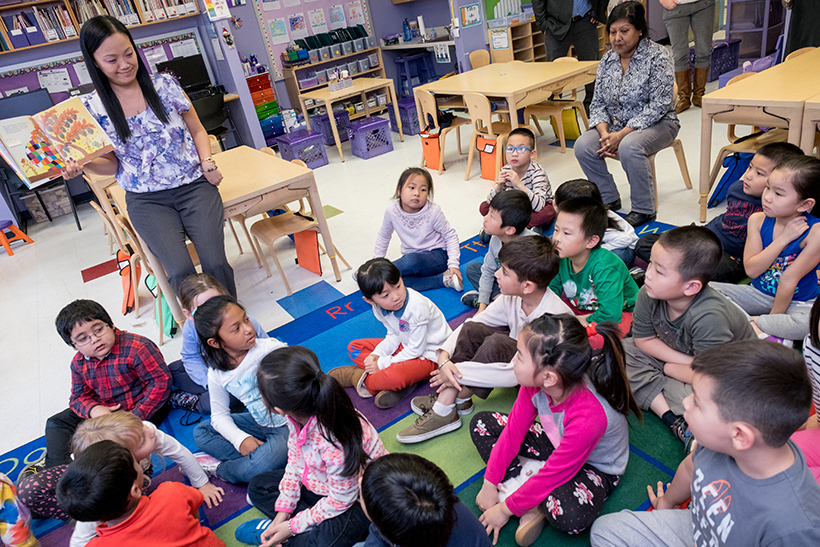This post was guest-authored by children’s librarian AnnMarie Hurtado.
I recently published a book to help children’s librarians enhance their storytime activities and infuse more creative writing into their children’s programs. As I researched and developed my book, 36 Workshops to Get Kids Writing: From Aliens to Zebras, I was very appreciative of the wealth of information and research on creative writing in the primary grades that I found in the publications of NCTE. In return I’d like to share a classroom activity that I think could be useful in libraries and classrooms alike.
The activities I developed all center on picture books likely to be found in public libraries.
In Everyone Loves Bacon, author Kelly DiPucchio and illustrator Eric Wight create a flawed protagonist who takes for granted that he is always the object of adoration and envy from the other foods in the diner. Bacon has lots of friends who are attracted to his charm, his sense of humor, and his wonderful smell. But other breakfast meats start to feel left out, having been forgotten in the glow of celebrity that has engulfed their former friend. In fact, he doesn’t seem to care about them anymore. Bacon has become stuck-up . . . but he’d better watch out, because celebrity doesn’t last forever!
I have found this charming book the perfect starting point for a simple reading and writing activity that gives everyone a chance to share their story from the storytelling chair. Here’s a general description of the steps:
- Have students sit on the floor while you take a seat in a “storyteller chair,” and read the book aloud. Ask the children how they would feel if a friend or family member became famous and then acted stuck-up
- Before class, gather some school supplies together and set them aside—such as a pencil, an eraser, a package of chalk, a stapler, a paintbrush, a ruler, a binder clip—things you might find together in a desk drawer. Since you and the students will be developing personalities for each one, it will facilitate the activity if at least some of the items are colorful or decorative.
- Using a flipchart pad or whiteboard, list the items and display them for everyone to see. Ask the kids to vote on which of these supplies should be the “rockstar” that all the others want to be like. Is the paintbrush envied for her shiny hair? Is the unicorn eraser adored for being so cute?
- List at least five characteristics for each object that contribute to its being admired. Feel free to expand beyond the obvious traits associated with the object (such as how well it writes, or how efficient it is)—brainstorm personality traits that make that object popular with her friends!
- Now you’ve established that there is one “rockstar” supply, the item in the desk drawer that everyone else wants to be like. How do the others feel about her or him, though? Are they jealous, or are they too busy admiring her or him?
- On a new page or part of the whiteboard draw a few of the characters—a pencil, a yellow crayon, a pair of scissors. Give them eyes and a mouth for personality. You don’t have to get fancy with your drawing, and you can invite a student to draw them if you would prefer.
- Put a word bubble over each character’s head. Then ask the students what should go in that word bubble. What kind of person is this character, and how does her personality affect what she thinks of Paintbrush? If the Pencil is nosy or bossy, for example, maybe she’s annoyed that Paintbrush always gets to decide what colors to use for Pencil’s drawings? Or if the Scissors character is friendly and kind, maybe he simply admires Paintbrush for being soft and having shiny hair.
- Listen to the students’ responses and write the characters’ opinions in their word bubbles. Here are some examples:
- Pencil: “Why is everyone coloring MY drawing without asking me what color they should use? Everybody only wants Paintbrush’s opinion, like she’s more special just because she’s an ‘artist.’”
- Scissors: “I just love the way Paintbrush’s hair swishes. I wish I was soft like Paintbrush!”
- Yellow Crayon: “I wish I could make other colors like Paintbrush. All I can make is Yellow. You can’t even see my marks on white paper most of the time.”
- Now the kids have a group of characters with a problem. They have everything they need to start constructing a basic story. To get them started, ask them to help you list some events that would shake up the community of the desk drawer. If they need help, offer a few suggestions as prompts. For instance:
- What if Paintbrush (or another rockstar character) left the desk drawer? Would she be missed? Would life in the desk drawer return to normal?
- What if Pencil got very angry and decided to pick a fight with Paintbrush? Would the other supplies come to his aid or would they take Paintbrush’s side?
- What if Paintbrush, in addition to being special and admired by the other supplies, was mean to them?
- What if Paintbrush was nice to the other supplies, especially to the jealous ones like Pencil? What would happen?
- Give the children another thirty minutes to craft their own stories. Encourage them to use dialogue for their characters to vent their feelings.
- Then when time is up, ask everyone to return to the floor and invite them to come one by one to the storyteller chair and share their stories. Students should not be forced to share, but most of them, seeing their peers share, will want a turn.
The final step is to compliment all the children on their characterizations, their dialogue, and their writing. In this activity, everyone’s a storyteller!

AnnMarie Hurtado is a children’s librarian at the Pasadena Public Library in Pasadena, California, and is author of the book 36 Workshops to Get Kids Writing: From Aliens to Zebras. She lives in Los Angeles.

